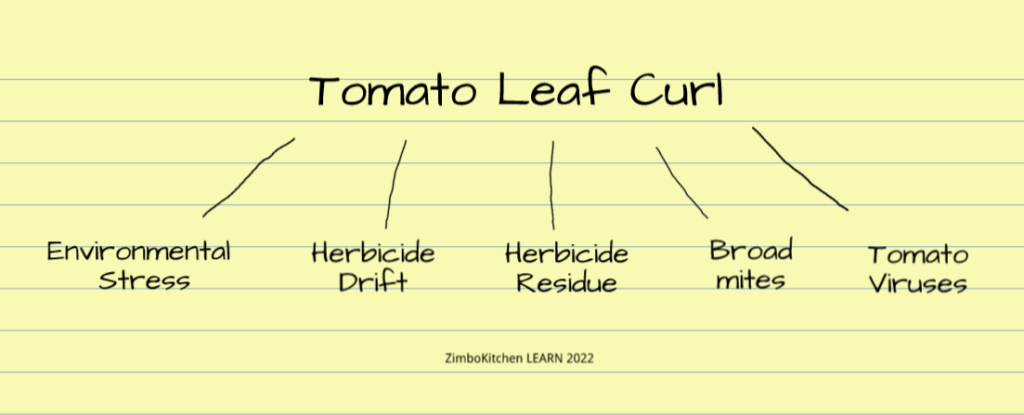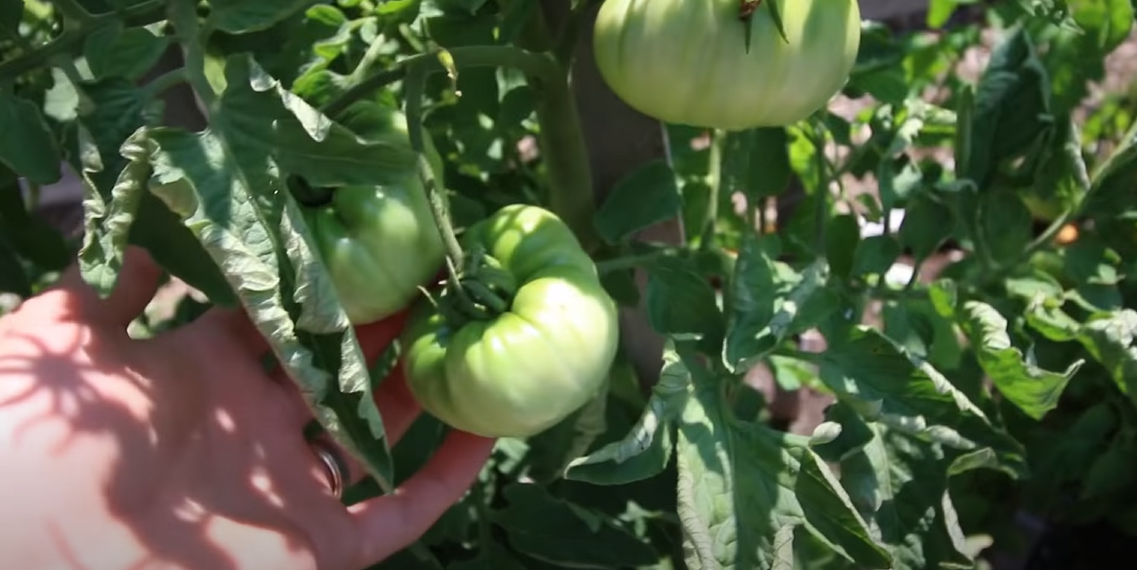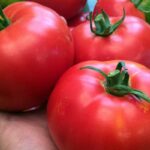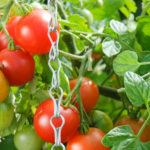Tomato leaf curl is a common physiological and disease-related problem that affects tomato plant leaves. The most common symptom is the rolling up, twisting or curling of the tomato plant leaves. There are a variety of causes, some of which are harmless while others write off the affected plant. Depending on the cause, tomato leaf curl can be reversed or resolve itself, often within hours. Furthermore, determinate and indeterminate tomato vines tend to be impacted by leaf curl quite differently.
Table of Contents
What is Tomato Leaf Curl?
Leaf curl is a plant physiology and disease issue that causes tomato plant leaves to roll up, twist or curl as a sign of some distress. Leaf curl affects all kinds of tomato varieties and cultivars from red tomatoes, yellow tomatoes, green tomatoes to black tomatoes.
Leaf curl does not only affect tomatoes but also other plant species. For example, fruit trees such as peaches are also affected by Peach leaf curl, a generally similar issue but specific to peach plants. As noted by the University of California’s Agriculture and Natural Resources, apart from tomato, leaf curl can also occur in peppers and eggplants. Other crops such as corn also suffer leaf curl under certain conditions.
According to Texas A&M AgriLife Extension Service, the problem of leaf curl in tomatoes can be environmental, chemical, or biological. Depending on the cause, the damage may begin slowly on a single plant, but then pick up pace to affect even new leaf growth and other adjacent tomato plants.
Altogether causes of tomato leaf curl can be appropriately grouped into five.
Useful Tomato Kitchen Utensils
Not all tomatoes fail. When all goes well with tomatoes, there is always a lot of them to deal with. There is certainly more to do with garden fresh tomatoes than most people are aware of. We have put together the following list of kitchen utensils that are very handy when working with tomatoes. These utensils expand the possibilities when working with tomatoes.
- Tomato strainer
- Tomato/Salsa Blender
- Food Processor for Tomatoes
- Tomato press
- Tomato mandoline for slicing
- Tomato slicer holder
- Heavy duty tomato slicer
- Tomato dicer
- Tomato corer
- Tomato jars for canning
- Tomato knife
- Tomato saver
- Countertop storage basket
- Tomato growing pots
Causes of Tomato Leaf Curl

Tomato Leaf Curl Caused by Environmental Stress
Environmental stress is one of the most common causes of leaf curl in tomatoes. Environmental stress is also alternatively referred to as the physiological cause of tomato leaf curl. This type of leaf curl is usually harmless and temporary. It also tends to resolve itself. As long as the leaf roll remains mild, there is little concern for tomato yields or tomato fruit quality. However, severe cases of tomato leaf curl can induce the dropping of flowers leading to reduced fruit set and lower yields.
It has been also observed that physiologically induced tomato leave curl affects determinate and indeterminate tomato vines differently. According to Clemson University Cooperative Extension Service, determinate tomato varieties are more resilient to environmental causes of leaf curl than the indeterminate ones. It is for this reason that this particular extension service recommends planting determinate tomato cultivars as an extra layer against environmental elements that induce leaf curling.
Excessive heat, dry weather, over-watering and wind are identifiable environmental elements that stress tomato plants triggering leaf rolling. Heat which has an effect of reducing moisture in plants causes the edges of the tomato leaves to die back, then twist and curl.
Furthermore, some tomato growers are surprised to find tomato leaves curling even if soil moisture supplies are fairly good. This is because on hot and windy afternoons there is rapid moisture loss. As a self defense mechanism to reduce water loss under such weather conditions, tomato leaves and leaflets naturally curl in order to reduce exposed leaf surface area. The tomato leaves will later relax to normal with no need for human intervention once the conditions have improved, usually within a few hours or within the same day.
Leaf Curl Caused by Herbicide Drift
Another important cause of leaf curl in tomatoes is herbicide drift. Herbicide drift occurs when wind carried herbicide spray from adjacent or near-by fields and plantations lands on tomato plants in sufficient quantities to cause harm. The bar is very low here. Texas A&M AgriLife Extension Service notes that drifting spray with herbicide concentrations as low as 0.1 ppm is sufficient to cause injury to tomato leaves.
Furthermore, it has been discovered that wind speeds as low as 5 mph or 8 km/h have enough lift to carry leaf curl causing herbicides through the air for up to a mile or 1.6 km. This means any tomato plants within this range are at great risk of suffering tomato leaf curl and other potential herbicide induced problems.
Some of the most common symptomatic signs of herbicide induced tomato leaf curling include downward bending of the petioles. Petiole refers to the stalk that joins the tomato leaf to the stem. Additionally, tomato leaflets will also suffer cupping and any new growth on the plant tends to be affected first.
Herbicides that could cause tomato leaf curl are hormone-type herbicides such as dicamba and 2,4-D which are used in the United States and elsewhere to control weeds. For example, dicamba is used to control broadleaf weeds in corn and soybeans fields. This same herbicide is sometimes also used in residential areas to treat lawns.
Tomatoes are known to be very sensitive to these herbicides which cause costly damage even at very low concentrations. The most notable effect even after recovery of the tomato leaves is a drop in yields. It has been observed that even when leaf curl does not apparently occur, tomato plants may still suffer low yields. If your tomato plants are suffering from mysterious low yields, there is merit in investigating potential herbicide drift or herbicide residue (see next section).
As can be determined from the foregoing, depending on the physical location of the garden with tomatoes, herbicide drift affects certain tomato growers and not others. For this reason, it is generally not as predominant as environmental stress in causing tomato leaf curl unless the tomato grower uses herbicides locally or is located close enough to an operation that uses these damaging herbicides
There is more to appreciate about herbicide drift and how it can affect tomatoes and other home garden vegetables, in general. For that we suggest the resource, 5 Things to Know to Avoid Herbicide Drift, by University of Nebraska-Lincoln Cropwatch.
Tomato Leaf Curl Caused by Herbicide Residue
Related to herbicide drift as a cause of tomato leaf curl is also herbicide residue. Herbicide residue in relation to tomato leaf curling occurs when material containing the residue of harmful herbicides makes contact with tomato plants. In particular, the most concerning herbicide in this respect is hormone-mimicking aminopyralid that is used by commercial farming operations to kill broad-leaved weeds.
Aminopyralid is a long lasting silent cause of leaf curling which gets into the home gardening ecosystem through composting and manure applied on vegetables. Hay or animal manure that has had contact with aminopyralid will retain the herbicide with its full potency for as much as three years. It has been shown that animals that eat aminopyralid sprayed grass release the potent herbicide in manure which in turn is used by some home gardeners in their organic farming efforts.
Whether used as manure, for composting or mulching, these by-products affect tomato plants that come into contact with the contaminated materials. Although there are now strict rules on the usage of aminopyralid, there still remains room for herbicide residue to find its way into tomato gardens leading to severe tomato leaf curl. This reported story out of the UK is a clear example of the effects of herbicide residue in causing extensive vegetable damage.
Leaf Curl Caused by Broad mites
Broad mites also known scientifically as Polyphagotarsonemus latus are a microscopic pest that is an important cause of tomato leaf curl. This pest is not only limited to tomato leaves but is also known to attack potatoes, peppers and eggplants among other vegetables.
According to the University of Delaware Extension, broad mites inject a toxin as they eat tomato leaves which causes leaf curl or shrivel. They are known to target young leaves and flowers and are light shy hence they occur on the underside of leaves.
The damage inflicted by broad mites on victim plants has a similar appearance to damage caused by herbicides or viruses. Leaves that have been attacked by the pest may look bronzed or russeted. The similarities in damage thus calls for broad mites identification to be an elaborate process. Identification of broad mites thus normally involves sending samples to a diagnostic lab.
Broad mites can be introduced into an otherwise clean tomato garden through transplants. Whiteflies are also another viable transmitter of broad mites. They carry the microscopic pests on their legs and antennae from one tomato plant to another effectively spreading leaf curl.
There is more to appreciate and learn about broad mites and their effect on tomatoes. We suggest this resource, Broadmite damage on tomatoes, by Texas A&M AgriLife Extension Service.
Tomato Leaf Curl Caused by Viruses
The last and final cause of tomato leaf curl on our list are tomato viruses. There are hundreds of tomato viruses that are capable of causing tomato leaf curl. Nevertheless, some viruses are more pronounced in certain regions than others.
For example, tomato yellow leaf curl virus (TYLCV) is the common virus in Texas and Southeast USA. In other places such as Australia, infection levels have been found to range between 5% and 100% of tomato crops. Tomato plants infected with TYLCV have leaflets that are rolled upwards and inwards in typical tomato leaf curl style. Furthermore, the leaves are often arched downwards, look thick and stiffer than usual with a leathery texture.
Unlike the physiological cause of leaf curling in tomatoes, TYLCV is a typical disease based cause of leaf rolling. As with other leaf curl causes, in its early stages tomato leaf curl caused by viruses has similar appearance to other causes such as herbicides. However, in the case of viral cause, the infected tomato leaves progress to include yellow-green mosaic patterns on the plant leaves.
The exact type of viruses behind tomato leaf curl belong to the geminivirus group. Once again whitefly, in particular silverleaf whitefly scientifically known as Bemisia tabaci, features prominently in the effective spread of geminiviruses. Considering that whitefly is a constant threat when trying to raise healthy tomatoes, there is considerable risk of the spread of tomato leaf curl by this means.
Tomato Leaf Curl Virus Treatment
It is sometimes asked, can tomatoes recover from leaf curl? The answer is it depends. It depends on the cause and the extent of the damage to the tomato leaf if any. As earlier mentioned, environmental causes of leaf curl in tomatoes such as wind and heat often do not cause permanent damage to tomato plants. Once the prevailing conditions change for the better the tomato leaves normalize without any need for any kind of treatment.
Nevertheless there is no remedy for curled leaves due to extensive injury from herbs such as 2,4-D herbicide. New leaves may grow which are normal and healthy. Depending on the extent of the injury, if there is no sign of recovery of the whole tomato plant, salvageable tomato fruit can be picked and the plant removed.
Tomato leaf curl caused by broad mites can be chemically treated especially if moderately affected. A common method of treatment is by using sulfur-based miticides. This type of treatment will need to be tomato cultivar specific as some tomato types are not tolerant to sulfur treatment. Specific conditions would also need to be met before treatment such as temperatures and the moisture condition of the crop.
Overall, controlling whitefly is an important way of managing the spread of broad mites considering that whitefly plays a key role in their spread. To tell if a tomato plant has whitefly, a gentle shake will cause any present to temporarily fly away often in numbers from the leaves. Whitefly infested tomato plants are treated by spraying insecticidal soap on the underside of the tomato leaves.
Conclusion
Tomato leaf curl is a rolling, twisting or curling of leaves often inwards and upwards which occurs to affected tomato plants. It has three main causes which are environmental, chemical and biological. Of these three, environmental causes have the less damaging effect and usually resolve on their own. Chemical causes often result in unrecoverable damage to tomato plants and involve events out of the growers direct control such as herbicide drift from close proximity fields. While leaf curl occurs in tomatoes, it is also common in other vegetables and crops.
Random But Good Reads:-


